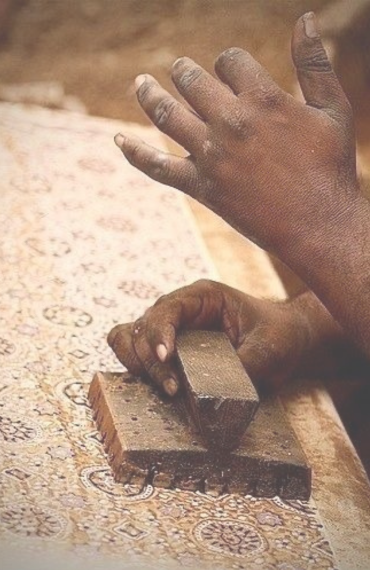
Hand Block Printing on Fabrics in India: A Timeless Art
Introduction
India has a rich heritage of textile traditions, and one of the most exquisite and time-honored techniques is hand block printing. This ancient craft has been practiced for centuries and continues to thrive, enchanting the world with its intricate designs and vibrant colors. Hand block printing is a labor-intensive process that involves skilled artisans carving intricate patterns on wooden blocks and then using them to print on fabrics. In this blog, we will delve into the captivating world of hand block printing, exploring its history, process, significance, and its enduring appeal in the modern era.
History of Hand Block Printing
The origins of hand block printing in India can be traced back over 2,000 years. The art form flourished under the patronage of Mughal rulers during the 12th century and later gained popularity during the Gujarat Sultanate in the 15th century. The technique then spread to various regions across the country, including Rajasthan, Gujarat, and Andhra Pradesh, each region adding its own unique style and flavor to the craft.
The Block Printing Process
Hand block printing is a meticulous process that requires immense skill and precision. It involves several stages, starting from the design creation to the final printing. Here's a simplified breakdown of the process:
Design Creation: Talented artists conceptualize intricate designs inspired by nature, mythology, or geometric patterns. These designs are then transferred onto tracing paper.
Block Carving: Skilled craftsmen, known as "Bhattis," carve the designs onto wooden blocks. Each block is made from sturdy wood such as teak or sheesham and consists of several motifs.
Preparing the Fabric: The fabric, usually cotton or silk, is washed and bleached to ensure a clean surface for printing. It is then soaked in a mixture of myrobalan (a natural mordant) and water to enhance color absorption.
Printing: The fabric is stretched on a long printing table, and the printer carefully dips the wooden block into the desired color pigment. The block is then pressed firmly onto the fabric, creating an impression of the design. This process is repeated meticulously to cover the entire fabric.
Drying and Finishing: The printed fabric is left to dry naturally, and after drying, it undergoes several post-printing processes, including washing, boiling, and sun-drying, to fix the color and enhance its longevity.
Significance and Symbolism
Hand block printing holds deep cultural and historical significance in India. The motifs and patterns used in block printing often reflect the region's heritage, religious beliefs, and folklore. For example, the famous Bagh prints from Madhya Pradesh feature floral and geometric patterns, while the Sanganer prints from Rajasthan showcase intricate designs inspired by nature, birds, and animals. These prints not only beautify the fabric but also convey stories and cultural symbolism.
The Timeless Appeal
Despite the advent of modern textile manufacturing techniques, hand block printing has retained its charm and continues to captivate people worldwide. Here are a few reasons for its enduring appeal:
Artistry and Craftsmanship: Hand block printing is a testament to the skill and artistry of the craftsmen. Each piece is unique, displaying the meticulous work of the block carvers and printers, making it a true work of art.
Sustainability and Eco-friendliness: Hand block printing utilizes natural dyes and eco-friendly practices, making it a sustainable choice in the world of textiles. The use of organic fabrics further enhances its environmental appeal.
Cultural Heritage: Hand block printing preserves India's cultural heritage and traditional craftsmanship. Wearing a hand block printed fabric is like carrying a piece of history and tradition with you.
Preservation of Local Communities: Hand block printing is often practiced in rural communities, providing employment opportunities and supporting local economies. By choosing hand block printed fabrics, you contribute to the livelihoods of artisans and help sustain these traditional communities.
Versatility and Adaptability: Hand block printed fabrics find their way into a variety of applications, ranging from clothing and home furnishings to accessories and decor items. The versatility of the craft allows it to adapt to modern fashion trends while maintaining its timeless appeal.
Revival of Traditional Crafts: In recent years, there has been a resurgence of interest in traditional crafts and handmade products. Hand block printing, with its rich heritage and intricate designs, has gained recognition globally as a unique and authentic art form. This revival not only preserves the craft but also provides opportunities for innovation and collaboration with contemporary designers.
Celebrating Individuality: In a world of mass-produced goods, hand block printing offers a way to express individuality and stand out from the crowd. Each block printed fabric has its own distinct imperfections, adding character and uniqueness to every piece.
Promoting Fair Trade and Ethical Practices: Many organizations and brands are committed to promoting fair trade and ensuring ethical practices in the hand block printing industry. By supporting these initiatives, you contribute to the empowerment of artisans, fair wages, and the protection of their rights.
Conclusion
Hand block printing on fabrics in India is not merely a craft; it is an embodiment of centuries-old traditions, artistry, and cultural heritage. It weaves together the skills of talented craftsmen, the stories of ancient motifs, and the beauty of natural dyes. The time and effort invested in each piece of hand block printed fabric create a connection between the artisan and the wearer, making it a cherished possession.
As we celebrate the legacy of hand block printing, let us recognize and appreciate the artisans who continue to breathe life into this art form. By choosing hand block printed fabrics, we not only embrace sustainable and ethically made textiles but also become patrons of a magnificent craft that has endured the test of time.
So, the next time you adorn yourself or your home with a hand block printed fabric, remember that you are not just wearing a piece of cloth but a piece of art that tells a story and carries the legacy of a tradition that has stood strong for centuries.



